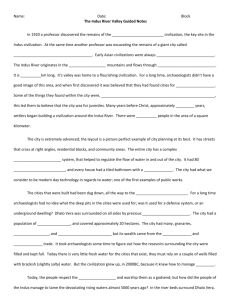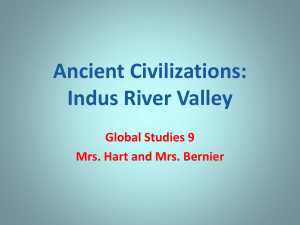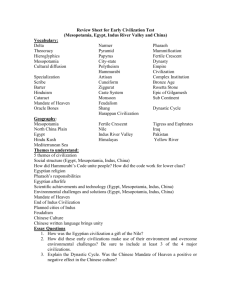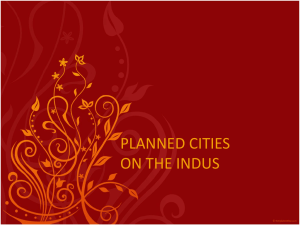File
advertisement
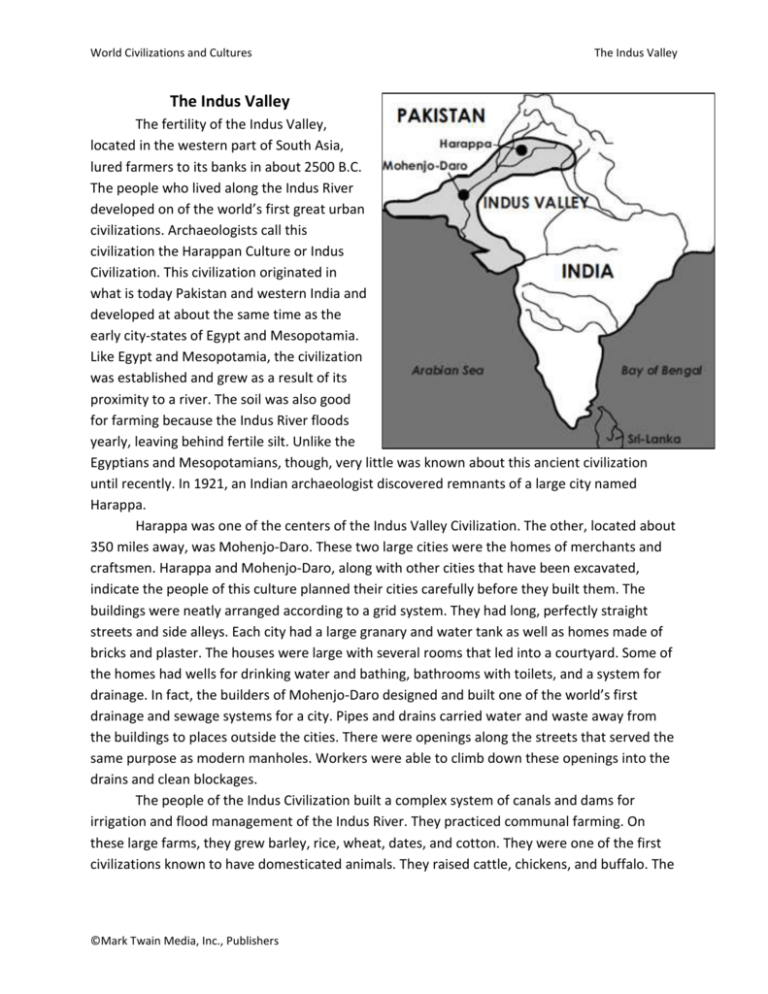
World Civilizations and Cultures The Indus Valley The Indus Valley The fertility of the Indus Valley, located in the western part of South Asia, lured farmers to its banks in about 2500 B.C. The people who lived along the Indus River developed on of the world’s first great urban civilizations. Archaeologists call this civilization the Harappan Culture or Indus Civilization. This civilization originated in what is today Pakistan and western India and developed at about the same time as the early city-states of Egypt and Mesopotamia. Like Egypt and Mesopotamia, the civilization was established and grew as a result of its proximity to a river. The soil was also good for farming because the Indus River floods yearly, leaving behind fertile silt. Unlike the Egyptians and Mesopotamians, though, very little was known about this ancient civilization until recently. In 1921, an Indian archaeologist discovered remnants of a large city named Harappa. Harappa was one of the centers of the Indus Valley Civilization. The other, located about 350 miles away, was Mohenjo-Daro. These two large cities were the homes of merchants and craftsmen. Harappa and Mohenjo-Daro, along with other cities that have been excavated, indicate the people of this culture planned their cities carefully before they built them. The buildings were neatly arranged according to a grid system. They had long, perfectly straight streets and side alleys. Each city had a large granary and water tank as well as homes made of bricks and plaster. The houses were large with several rooms that led into a courtyard. Some of the homes had wells for drinking water and bathing, bathrooms with toilets, and a system for drainage. In fact, the builders of Mohenjo-Daro designed and built one of the world’s first drainage and sewage systems for a city. Pipes and drains carried water and waste away from the buildings to places outside the cities. There were openings along the streets that served the same purpose as modern manholes. Workers were able to climb down these openings into the drains and clean blockages. The people of the Indus Civilization built a complex system of canals and dams for irrigation and flood management of the Indus River. They practiced communal farming. On these large farms, they grew barley, rice, wheat, dates, and cotton. They were one of the first civilizations known to have domesticated animals. They raised cattle, chickens, and buffalo. The ©Mark Twain Media, Inc., Publishers World Civilizations and Cultures The Indus Valley farmers used wheeled carts drawn by oxen to Indus Civilization at a Glance take their grain to the cities where it was sorted Where: western part of South Asia in what is in large granaries. now Pakistan and western India Those who did not farm or hunt were When: 2500 B.C. – 1750 B.C. either tradesmen or craftsmen. Trading with others was natural since people of the Indus Achievements: Civilization could travel by water along the - Built dams and canals for irrigation rivers or along the coastline to other cultures. - Well-planned cities They bought gold from southern India, - One of the world’s first drainage and sewer systems for a city turquoise from Iran, silver and copper from - Among the first people to cultivate Afghanistan, and jade from India. With these cotton goods, craftsmen were able to make pottery, - Among the first people to domesticate jewelry, sculptures, spears, and knives. animals About 1750 B.C. the civilization began to decline. The country was rocked by earthquakes and floods that destroyed the irrigation system supplying water to the crops. Many buildings were also destroyed. For some reason, the people seemed to have lost their will to rebuild. Invaders caused many to abandon the Indus Valley. Although nomads lived in this region for a while, hundreds of years would pass before new cities were built. While the Indus Civilization was not as wealthy and did not contribute as much as the Egyptians, Sumerians, or the Chinese, they were able to clean the jungle, build an elaborate irrigation system, design large cities, and develop a culture in a rather short period of time. A statue artifact from the Indus Valley Civilization ©Mark Twain Media, Inc., Publishers World Civilizations and Cultures The Indus Valley Name: ______________________________ Date: _________ Period: ________ The Indus Valley 1. When did people begin to live in the Indus Valley? __2500 B.C.______ 2. The civilization of the Harappans, like Egypt and Mesopotamia, developed along what geographic feature? ____river____ 3. Name two modern countries that exist in the Indus Valley today __________________Pakistan and India________________________________ 4. Go back to the first paragraph. Name one way the Indus Valley was LIKE Egypt. _____________developed along a river_______________________________________ Name one way the Indus Valley was different than Egypt. _____________little known until recently_____________________________________ 5. Name the two large cities that were in the Indus Valley in ancient times. _______Harappa_______ and _______Mohenjo-Daro_____ 6. The people of Mohenjo-Daro had the world’s first _________drainage____________ and ______sewer______ systems. 7. What did the Indus Valley buy from Iran? _____turquoise________ 8. What did the Indus Valley buy from India? _____gold_______ and ____jade______ 9. According to the article, what two natural disasters could have caused the Indus Civilization to decline? ____earthquakes____ and _____flooding_____ 10. Why is the Indus Civilization not as well-known as Egypt, Mesopotamia, or China? ________did not rebuild, abandoned the Indus Valley___________________________ 11. According to the graphic organizer, Indus Civilization at a glance, how long did the Indus Civilization exist? ___750 years_____________ 12. Look at the map. What direction would a trader travel to go from Mohenjo-Daro to Harrapa? _____northeast_____ 13. What mountain ranges are north of the Indus Valley? ______Himalayas____ and ______Hindu Kush Mountains________ 14. The Indus River empties into what large body of water? ____Arabian Sea______ ©Mark Twain Media, Inc., Publishers




![Indus[1] - ridgeaphistory](http://s3.studylib.net/store/data/006736077_1-c59280ecd30594bac8ab21ec7bce4db4-300x300.png)
